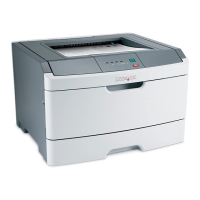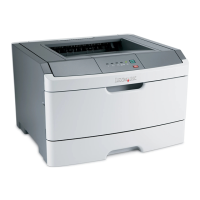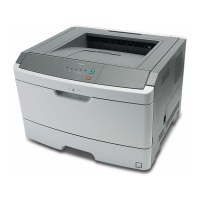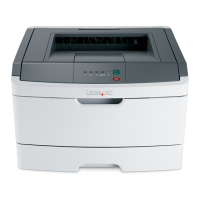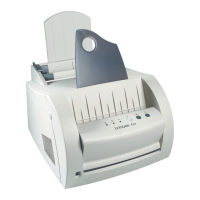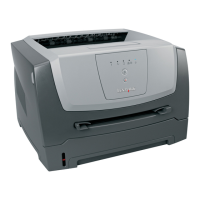Diagnostics information 2-37
4513-220, -230
200.14 Trailing edge cleared manual feed, but did not successfully debounce the sensor. Potential causes are a small
gap or a bouncy manual feed sensor.
200.15 UNRECOVERABLE NO GAP JAM. Engine detected no gap at the manual feeder sensor, attempted to open
the gap by stopping the feed rolls, but no trailing edge was ever seen at the input sensor.
200.16 Transport motor error detected
200.17 Took too long to ramp up transport motor
200.18 Manual feeder sensor never became uncovered from the sheet ahead.
200.19 The media never reached the input sensor, but was detected at manual feeder sensor.
200.20 The media is too long over the manual feeder sensor. Possible causes include multi-sheet feed, media size
(length) problem, pre-staged media in the tray.
200.22 FAILED SMALL GAP OR NO GAP JAM RECOVERY. Engine detected small gap or no gap at the manual
feeder sensor, opened the gap by stopping the feed rolls, but never saw the leading edge of the second page
at the input sensor.
200.23 Laser Servo never started due to potential conflict with the transfer servo. Possible causes: slow or missing
transport motor positional feedback, or the media is transferred too quickly to the input sensor.
200.24 The measured gap at the input sensor is too small to meet the video delivery requirements. (There is not
enough time since prior image finished to start new image)
200.26 The trailing edge never cleared the input sensor when feeding out the media that was detected during warm-
up.
200.27 Printhead Driver: Mirror motor fell out of lock condition after the media at the input sensor–more time elapsed
since the printhead than the expected stable lock time, but less than the printhead jitter-stable specification.
Mirror motor fell out of lock condition after media at the input sensor–more time elapsed since the printhead
than expected stable lock time, but less than the printhead jitter-stable specification.
200.28 First writing line of a page at the developer nip, but laser servo cleanup is not complete. Likely pre staged
media or a fast paper feed.
200.29 Printhead drive control out of range due to an external event beyond what the control is designed to handle.
Probable causes: ESD or noise on hsync signal.
200.30 Narrow media sensor covered during warm-up.
200.32 Media more than 14 inches too long over the manual feeder sensor. Possible causes include multi-sheet feed
or pre-staged media in the tray.
200.33 Page from tray 1 did not reach the input sensor after multiple attempts. Page did make it out of the tray at least
as far as the manual feeder sensor. Possible cause is that the page stalled at the alignment gate.
200.34 Timed out waiting for page from tray 1 to reach the input sensor after multiple pick attempts, but the page was
later detected at the input sensor while waiting for any page(s) ahead to clear the paper path. Possible cause
is that the page is delayed at the alignment gate.
200.35 Failed to create hsync during auto alignment
200.36 Lost hsyncs during auto alignment
200.37 Timeout on data collection during auto alignment
200.38 Interpage servo gap is smaller than expected for printhead offset target evaluation
200.39 Auto alignment is taking too long to run.
Paper jam error codes (200-series) (Continued)
Error Description
